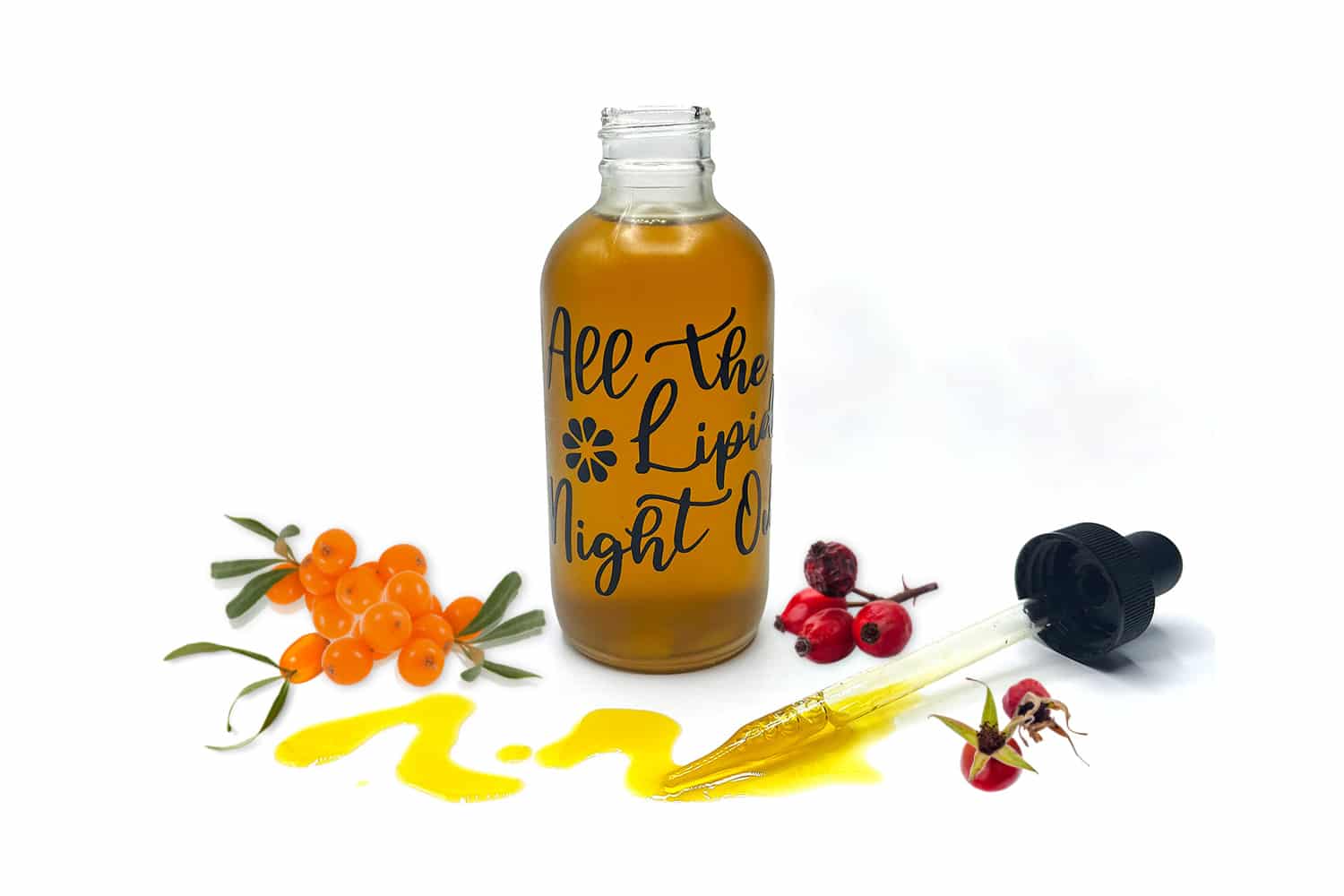Awhile back, I was given a sample of Skin Active’s Every Lipid Serum to try out and really liked it. So of course, I immediately set out to make my own version. It started out as a pretty solid dupe, but true to form, I ended up going a bit rogue. (*squirrel!* *shiny ball!* *herbs!!*)
Oil serums can be great for supplementing the skin’s protective lipid barrier and replacing what has been stripped away by cold weather, overzealous exfoliation and harsh cleansers. The absolute best time to slap this stuff on is after a shower when your skin is damp. The oil helps to lock in all that moisture, hold it against the skin and prevent it from evaporating.
Every Lipid is marketed as the “ultimate rejuvenating facial oil” that “provides every lipid necessary to help support a healthy skin barrier.” It’s ingredient list looks like this:
squalane, flaxseed oil, rosehip seed oil, lecithin, chia seed oil, pomegranate seed oil, argan kernel oil, vitamin E, astaxanthin, lycopene, xanthophyll, alpha lipoic acid, beta carotene, docosahexanoic acid, ceramide-3, cholesteryl oleyl carbonate, cholesteryl nonanoate, cholesteryl chloride, BHT, phytosterols, oryzanol.
So let’s work our way through the list.
Squalane (& jojoba?)
Squalane is a light and lovely oil (okay, technically a hydrocarbon) that I often incorporate into my skincare formulas. There’s a reason it feels so nice on the skin. Squalene makes up about 10-16% of what is found in our own skin’s natural surface lipids. Combined with the wax monoesters in jojoba oil at about a 1:2 (squalane to jojoba) ratio, and you’ve got a pretty decent mimic for up to 38% or more of what makes up human sebum.
For this reason, I decided to include jojoba in my oil blend, despite it not being part of the original Every Lipid product.
Sea buckthorn
Also not specifically on the list, but I really wanted to incorporate sea buckthorn fruit into this recipe. Hippophae rhamnoides is a potent anti-inflammatory and may be helpful for reducing redness and improving the appearance of scarring. It’s also a rich source of omega-7 fatty acids and carotenoids such as lycopene, beta-carotene and xanthophyll — all of which are included as isolates in Every Lipid.
Sea buckthorn fruit oil is one of the best sources of palmitoleic acid, a fatty acid present in our own skin lipids, that decreases as we age. Incidentally, human skin surface lipids naturally contain retinol, retinyl esters, as well as carotenoids, which are precursors to vitamin A/retinol. Studies have confirmed that enzymes involved in retinoid metabolism are present in human epidermis, so topical carotenoids such as beta-carotene can be successfully converted into bioavailable retinyl esters. Great news for those of us who’d prefer not to use synthetic retinol!
The main trouble with sea buckthorn fruit oil, is that it’s stupid-expensive. After I recovered from the initial sticker shock, I decided that the best way to get around the jaw dropping price tag was to infuse my own oil with sea buckthorn fruit, which is far cheaper and goes a lot further than a tiny bottle of cold pressed fruit oil. I purchased the fruit powder from Mountain Rose Herbs, and infused my jojoba oil using an alcohol intermediary infusion method. The result was a gorgeous bright orange jojoba. Perhaps slightly less potent than the pure, cold-pressed oil, but it’s much easier on the pocketbook.
Behold, a beautiful jojoba oil infused with sea buckthorn fruit in all its bright orange, carotenoid-y splendor:
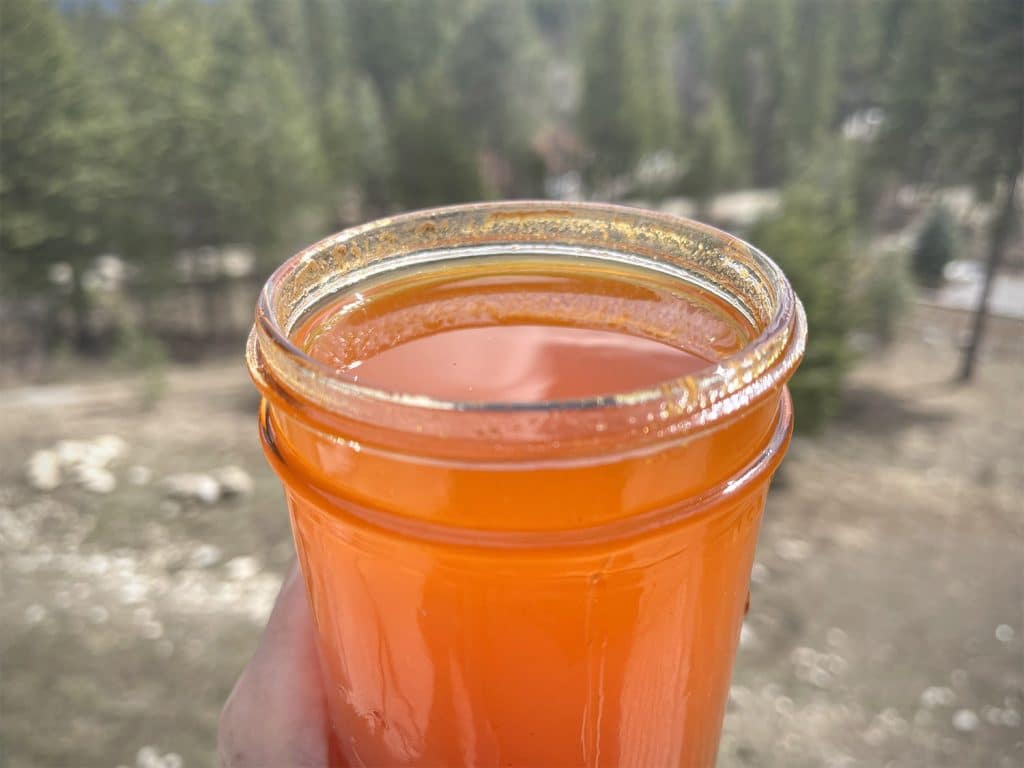
By the way, if you do decide to spring for the sea buckthorn oil instead of infusing your own, you’re looking for the variety derived from the fruit (sometimes called pulp) and NOT the seed oil. The fatty acid compositions of the two oils (particularly the palmitoleic acid content) differ considerably. You’re looking for an oil that’s bright orange. I’ve been burned a couple of times by sellers on Amazon who claimed their product was pressed from the fruit, but then received a bottle of clear oil. That’s not sea buckthorn fruit/pulp oil. There’s just no mistaking it. Mountain Rose Herbs has the real deal — cold pressed using the entire berry, in all its Oompa Loompa-orangey goodness.
(Fair warning: a little goes a looooong way. Using sea buckthorn fruit oil undiluted is a sure ticket to Oompa Loompa Town. This stuff stains!)

Flaxseed oil
Topical application of anti-inflammatory omega 3s may help to improve barrier function and protect skin against environmental stressors. Flaxseed (Linum usitatissimum) oil is composed, primarily (39-60%) of alpha-linolenic acid, a type of omega-3 fatty acid typically found in plants. Flaxseed also contains lignans, a type of antioxidant and phytoestrogen that may be helpful in regulating excessive sebum production in addition to reducing redness and irritation and improving skin’s sensitivity. It’s also an important structural component of healthy cell membranes. According to Ayurveda, flaxseed oil can also balance the skin’s pH, improve its strength or elasticity and speed wound healing.
Rosehip seed oil
Rosehip seed oil (Rosa spp.) contains trans retinoic acid, a natural form of vitamin A, which has similar effect to commercial retinol when applied topically. Retinol, as you probably know, is synthetic vitamin A, which is said to promote skin cell rejuvenation, improves wrinkles, fine lines and acne scars, boosts elasticity and fades age spots.
For those of us who still get the occasional zit, (moi? surely not!) rosehip oil contains relatively high levels of linoleic acid (30-35%), an omega-6 polyunsaturated essential fatty acid associated with clear, blemish-free skin. Interestingly, some studies suggest a deficiency of linoleic acid may actually be a cause of acne breakouts and inflammation, which seems odd to me because linoleic acid is the most highly consumed PUFA found in the human diet. Still, according to the PubMed article, Sebaceous Gland Lipids:
“A diminished amount of linoleic acid has been proposed as a factor predisposing to comedones formation. Moreover, low level of linoleic acid also produces impairment of the epidermal barrier function, which might account for increased permeability of comedonal wall to inflammatory substances.”
It’s worth mentioning that, despite claims to the contrary all over the Internet, it is a MYTH that rosehip oil contains vitamin C. Yes, fresh rosehip berries are loaded with vitamin C, but the oil, which is pressed from the seeds of the rosehip berry, does not contain any, since C is a water soluble vitamin. Yep, those pesky solubility rules again. That’s not to say that rosehip oil isn’t wonderful for the skin, it just isn’t a viable source of C vitamins. Same story for the sea buckthorn oil. Lots of vitamin C in the berry, but it does not extract in oil. Sorry!
This oil blend is plenty potent all by itself, but if you did want to add vitamin C to an anhydrous (anhydrous = no water) formula like this one, Tetrahexyldecyl Ascorbate is a good option. TA is a very stable vitamin C ester that’s soluble in oil and doesn’t oxidize immediately like ascorbic acid does, giving it decent shelf stability. I usually work with TA at about 5% of the formula, but its recommended usage is between 1-10%, so you can customize until your heart’s content.

Lecithin
This is a pretty nifty trick to improve the skin feel of anhydrous formulas. Lecithin is one of the few “natural” emulsifiers out there, and it adds humectant and emollient properties to the formula. Emulsifiers have a hydrophilic (polar) head, and a lipophilic (non-polar) tail that bind to oil and water allowing them to mix when they otherwise would not.
But why use an emulsifier in a product that contains no water?
In a nutshell, the emulsifier isn’t “activated” until water is introduced via rinsing, The emulsifier binds the excess oil to the rinse water, leaving skin feeling moisturized, but not oily. Neat!
Pomegranate seed oil
I didn’t have any pomegranate seed oil (Punica granatum) and was very tempted to dismiss it as another trendy cosmeceutical. However, after reading a bit about its rather unique punicic acid content (nearly 70%), I decided to spring for a bottle. Punicic acid is a long-chain omega-5 fatty acid that is sort of a “super” conjugated linolenic acid (CLA) with sun protective and epidermis (skin) regenerating qualities. It stimulates keratinocyte proliferation, meaning it may be able to thicken aging, thinning skin. (Sign me up!) At some point, I may try infusing my own pomegranate seed oil using fresh dried pomegranate seeds, but for now, the pomegranate seed oil is affordable enough to start experimenting.
Astaxanthin
Since it’s an oil soluble antioxidant, I decided to infuse my squalane with Irish moss Instead of attempting to source isolated astaxanthin for my formula. Chondrus crispus is a type of red algae from which astaxanthin — a naturally occurring carotenoid that’s also responsible for giving salmon and flamingoes their pinky-red color — is derived. Irish Sea Moss also contains high levels of vitamins A, E, K as well as sulfur, calcium, potassium and iodine.
Irish moss infused squalane:
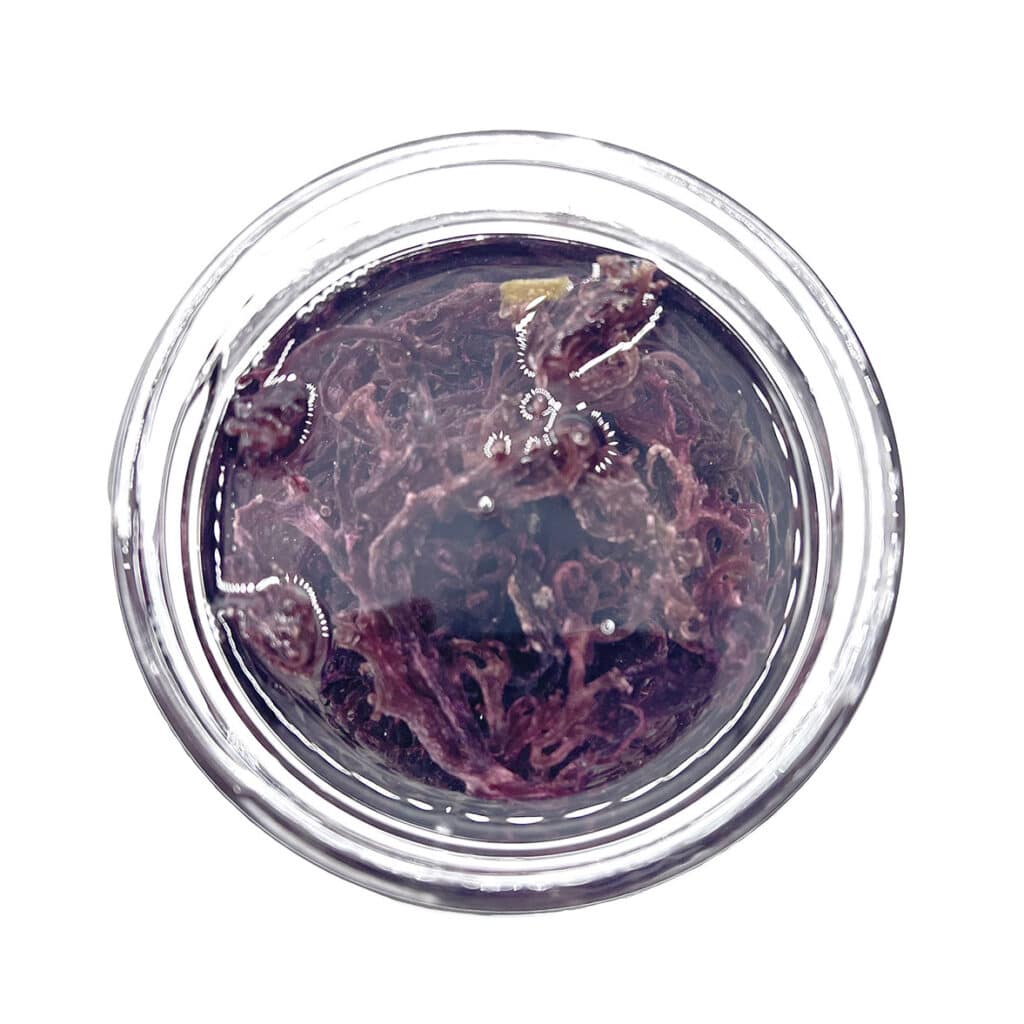
Astaxanthin’s usefulness as an antioxidant in topical applications may or may not be limited, but a handful of studies suggest (at least in mice and in vitro) that the synergistic combination of squalene and astaxanthin may increase its antioxidant benefits. The combo resulted in higher activation of antioxidant enzymes (GPX1 and SOD1) than either substance by itself.
Oryzanol
Oryzanol is an oil-soluble nutrient isolated from rice bran (and a few other botanicals) that is a natural source of ferulic acid. Ferulic acid may sound familiar since it’s a popular “active” in skincare formulas thanks to its free radical scavenging capabilities and efficacy in treating hyperpigmentation, age spots, etc. For my oil blend, instead of finding an oryzanol isolate, we’re just going to add a bit of organic rice bran oil.
Carrot resin
Carrot resin is another “rogue” addition that was not a part of the original ‘Every Lipid’ blend. Feel free to omit since it’s kind of an unusual ingredient to have just laying around the house. Carrot (Daucus Carota) is said to be an excellent therapy for dry or mature skin, full of antioxidants and supportive of skin cell turnover/regeneration.
According to the Formulator Sample Shop, carrot resin is an oil-soluble blend of carrot oil (extracted from the seeds of the carrot plant) and carrot extract. As you might expect from a carotenoid-heavy additive, carrot resin is rich red color and plays nicely with our carotenoid theme.
Essential oils
As always, it’s perfectly fine to skip the essential oils if you’re comfortable with an earthy, herbal-y smelling product. For a long time, I made this using a blend of rose* and helichrysum (pronounced helly-chris-um) essential oils, since they smell lovely together and both EOs are well-studied skin helpers, contributing to rejuvenating distressed or aging skin.
* Like neroli, rose essential oils have never been exactly cheap, but lately, the prices have really gone through the roof. If you don’t already have a bottle stashed away somewhere, feel free to omit or substitute a less insanely priced EO. Lavender or bergamot both pair nicely with helichrysum.
A few omissions
I decided to skip adding chia seed oil to my recipe because 1. I don’t have any, and 2. as far as I can tell, its main purpose in the formula is to add additional omega 3s to the blend. Flaxseed oil already accomplishes that, and I have some in my refrigerator.
Another expensive and (in my opinion) overrated oil is argan oil. I omitted it because I didn’t have any, and also because don’t see that it adds anything unique to this recipe that isn’t already covered by one of the other oils. It contains a relatively large amounts of vitamin E, but we’ve already got that covered with the addition of… vitamin E oil.
The final ingredients on the list with the long, intimidating looking names are a ceramide complex and various cholesterol esters. There are ready-made ceramide complexes out there that you can purchase to add to your formulations if you like, but if you’ve read my Not-Petroleum Jelly post, then you already know I’m skeptical about the efficacy of topical ceramides. I opted to leave them out of this recipe.
I also question how much the various “cholesteryl” ingredients and added phytosterols are bringing to the table when squalene is a cholesterol precursor and each of the botanical oils are also going to contribute varying amounts of “plant cholesterol” in the form of phytosterols. Most non-vegan cosmetic cholesterol is derived from sheep’s wool lanolin. There are also various cholesteryl additives to be had online, this one derived from “sheep wool derivatives” (aka lanolin). Personally, if I wanted to increase the cholesterol content of the oil blend, I would simply add a small amount of lanolin at around 1% of the total recipe (by weight) to avoid over-thickening the oil blend.
Docosahexaenoic acid is an omega-3 fatty acid that flaxseed’s alpha-linolenic acid converts to in the body. It might contribute something magical to this formula, but it might also be covered by the flaxseed oil. I’m not sure, but I’m choosing to omit it.
Lastly, butylated hydroxytoluene (BHT) is a man-made antioxidant that I think we can also omit, since virtually every other ingredient in this recipe is an antioxidant of some sort.
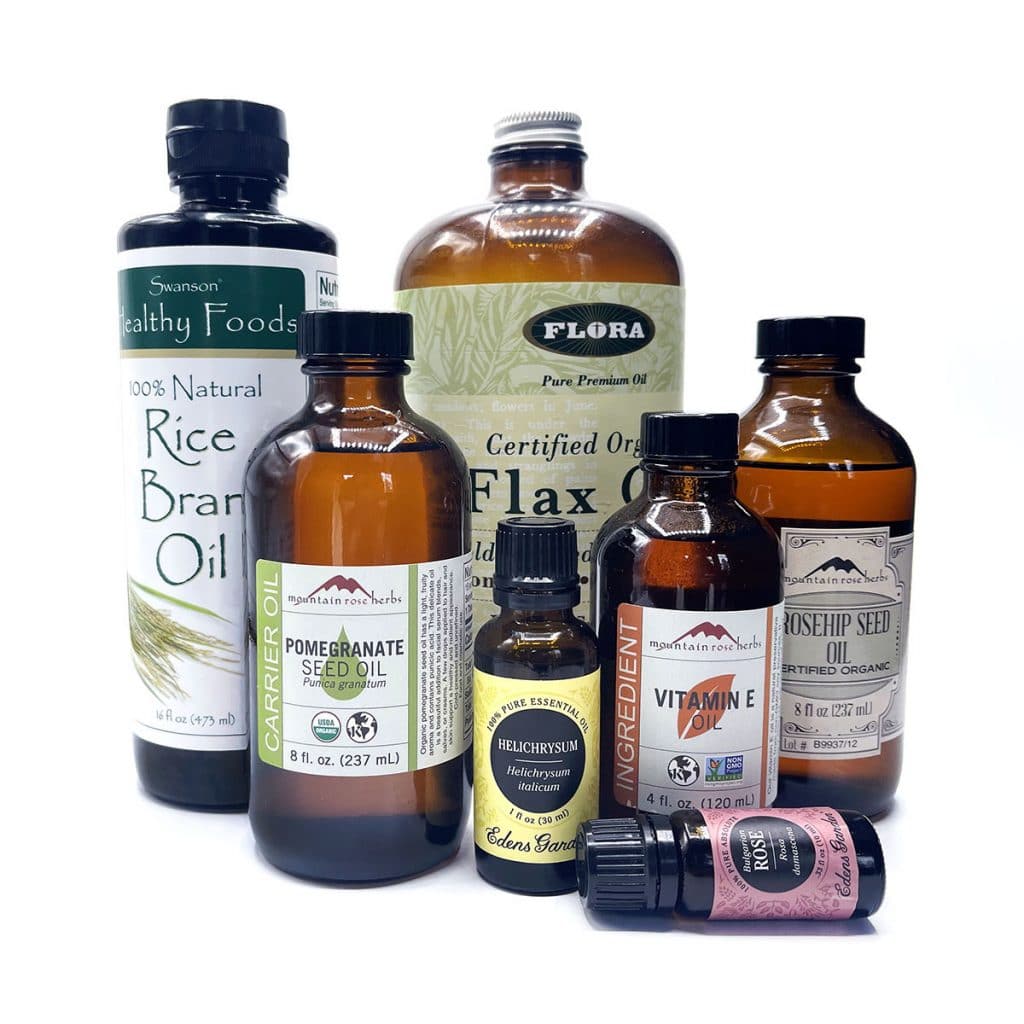
Saturated, mono & polyunsaturated oils (oh my!)
Still with me? That was a lot, lol.
I may have mentioned once or twice that I’m a bit wary of using too many polyunsaturated oils in skincare, since they’re unstable and prone to oxidation. Squalane is 100% saturated and jojoba is primarily monounsaturated, making them both resistant to rancidity. The rest of the botanical oils in this recipe are polyunsaturated and far less stable, giving them a shorter shelf life. But combined with the massive amounts of antioxidants in this formula, plus some vitamin E for good measure, I feel like overall, we’re still winding up with a relatively oxidation-resistant oil blend.
I’m un-creatively giving this oil blend a working name of “All the Lipids” as a nod to the product that inspired it, but I’m thinking something that acknowledges the colorful orangey-ness of the oil would be better, especially since the original ‘Every Lipid’ is a totally clear oil blend.
Orange Obsession: by Oompa Loompa
The Orange Wonder Oil
CarotenOIL …?
♥
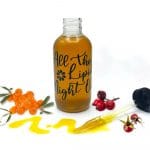
‘All the Lipids’ Facial Oil
5 Stars 4 Stars 3 Stars 2 Stars 1 Star
No reviews
Ingredients
24 g jojoba oil, infused with sea buckthorn fruit
12 g squalane, infused with Irish moss
12 g rosehip seed oil
12 g flaxseed oil
10 g pomegranate seed oil
10 g rice bran oil
10 g carrot resin (optional)
4 g vitamin E oil
3 g liquid lecithin
8 drops helichrysum essential oil (optional)
8 drops lavender essential oil (optional)
8 drops bergamot essential oil (optional)
Instructions
- Place your beaker or jar on a scale and proceed to add each of the ingredients by weight.
- Use immersion blender to homogenize the oil blend.
- Transfer to your storage bottle and label.
- Best used on damp skin after bathing ♥
Notes
I recommend glass containers for storing homemade lotions and potions. Glass doesn’t leach chemicals and it’s easier to clean/sterilize after the product is used up and you’re ready to refill.
If you do choose to use a plastic container, be aware that essential oils tend to react with plastic, so even if you can get it “clean,” your container will likely not be reusable.

